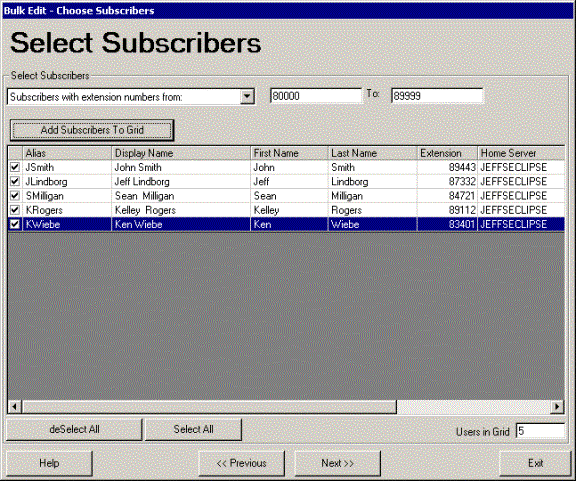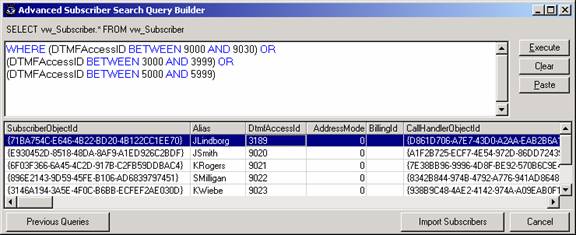Bulk Subscriber Logout
Logging Subscribers Out or
Resynching Subscribers
Overview
By default the Unity message store monitor service logs into every Unity subscriber’s mailbox that it’s responsible for and watches for changes to it’s mailbox status. This is used to know when to trigger MWI on/off events or to fire a notification event if the user has one or more configured.
For systems running on Exchange 5.5 you must make sure all clients, including the message store monitor, are logged out of the user’s mailboxes before you can move them. If you don’t, the mailstore can leave multiple copies of the same mailbox around which can create problems. For Exchange 2000/2003 this is no longer necessary as Exchange handles this better. However for cases where a site is having problems with MWI activity not being consistent or for whatever reason the mailbox monitor services is not properly monitoring some mailboxes it can be helpful to force it to log out of selected mailboxes and then log back in without restarting the service entirely or restarting Unity entirely.

The Bulk Subscriber Logout tool allows you to select any number of subscribers in the system and force the message store monitor service to log out of those mailboxes or to log back into those mailboxes again. Typically it’s used for Exchange 5.5 installs by having it log all users out, then moving their mailboxes in Exchange and then having it log back into those mailboxes after the move has completed. For Exchange 2000/2003 installs it’s typically used for troubleshooting scenarios by forcing a subset of boxes to logout and then log back in to force the notification processes to get back on track for users having problems.
Requirements/Special Notes
This version of Bulk Subscriber Logout can only be run on Unity 4.0(4) and later installations.
This tool must be run “on box”, it cannot be installed and run remotely.
This tool only works on systems installed with Exchange 5.5, Exchange 2000 and Exchange 2003. You cannot use Bulk Subscriber Logout with system attached to a Domino mail server.
You need to be logged in as a member of the local administrators group on the local Unity server to run this tool properly. This will ensure you have all the rights in the SQL database that are necessary.
Using Bulk Subscriber Logout
Bulk Subscriber Logout is a simple 3 panel wizard that walks you through the process of selecting the subscribers you want to logout or resynch from the mailbox monitoring service and the actual logout/resynch process.
The first page of the wizard is simply and introduction and an explanation of what the tool does – if you hit “next” you can start the process of selecting subscribers to act on.
Selecting Subscribers

On this panel you select which subscribers you wish to log out or resych. You can select subscribers by several mechanisms by using the “Select Subscribers” drop down list, providing a range or selecting an option and pressing the “Add subscribers to Grid” button. This will clear the grid and add only your latest selection to the grid of users. There’s no way to “merge” multiple ranges of users into the grid, if you wish to logout or resynch multiple groups of users based on different criteria, you will need to run the Bulk Subscriber Logout tool multiple times. There is an advanced selection method that lets you do custom SQL queries, however, that is discussed below.
There are six options for adding users to the grid:
![]() All subscribers. This includes all valid full subscribers
(not internet, AMIS, Bridge or VPIM subscribers) in the grid. You can then unselect users you
don’t want to remove from the system by unchecking the box on the
left. You can also select all users
or deselect all users using the buttons at the bottom of the grid. Be careful not
to remove ALL your subscribers here as you need to leave at least one
administrator!
All subscribers. This includes all valid full subscribers
(not internet, AMIS, Bridge or VPIM subscribers) in the grid. You can then unselect users you
don’t want to remove from the system by unchecking the box on the
left. You can also select all users
or deselect all users using the buttons at the bottom of the grid. Be careful not
to remove ALL your subscribers here as you need to leave at least one
administrator!
![]() Subscribers with extension numbers from:. This lets you specify a starting and
ending range of extensions to select subscribers by (see screen shot above)
Subscribers with extension numbers from:. This lets you specify a starting and
ending range of extensions to select subscribers by (see screen shot above)
![]() Subscribers
associated with this switch. You can select a switch that users are
associated with in a dual switch integration. All subscribers associated with the
selected switch will be included in the grid.
Subscribers
associated with this switch. You can select a switch that users are
associated with in a dual switch integration. All subscribers associated with the
selected switch will be included in the grid.
![]() Subscribers
associated with this class of service. You can select a specific
class of service and all users assigned to that COS will be added to the grid.
Subscribers
associated with this class of service. You can select a specific
class of service and all users assigned to that COS will be added to the grid.
![]() Subscribers
homed on this mail server. You can select a specific Exchange
mail server and all subscriber’s that have their mailstores on that
server will be included in the grid.
Subscribers
homed on this mail server. You can select a specific Exchange
mail server and all subscriber’s that have their mailstores on that
server will be included in the grid.
![]() Subscribers referenced in this CSV file. This option lets you select a
comma-separated value (CSV) file to find subscribers based on their Exchange
aliases. CSV is a common text file format for moving data from one data store
to another. You can edit CSV files in a text editor or in a spreadsheet
application. If you choose to select subscribers from a CSV file, format your
file by using the following guidelines to ensure that it parses correctly:
Subscribers referenced in this CSV file. This option lets you select a
comma-separated value (CSV) file to find subscribers based on their Exchange
aliases. CSV is a common text file format for moving data from one data store
to another. You can edit CSV files in a text editor or in a spreadsheet
application. If you choose to select subscribers from a CSV file, format your
file by using the following guidelines to ensure that it parses correctly:
![]() Separate values by commas. Do not use a tab,
spaces, or a semicolon to separate values in the file.
Separate values by commas. Do not use a tab,
spaces, or a semicolon to separate values in the file.
![]() Include a column header titled
“alias” in the first line. Column headers are not case sensitive,
and can be formatted with spaces on the left, right, or on both sides.
Include a column header titled
“alias” in the first line. Column headers are not case sensitive,
and can be formatted with spaces on the left, right, or on both sides.
For example:
first name, last name, home server,
alias
Alex, Abade, EXServer1, aabade
Kelly, Bader, EXServer1, kbader
Once you have the
grid populated with the subscribers you want, you can “cherry pick”
individual users and select/unselect them using the checkbox column on the far
left of the grid. All
subscribers that have their box checked will be logged out or resynched, those
that have a cleared box will be skipped.
You can clear or check all boxes in the grid using the “select
all” and “deselect all” buttons in the lower left of the
form.
Once you have the subscribers selected the way you want them, press the “Next” button and advanced to the next panel in the wizard.
Advanced Subscriber Selection
If you ran the Bulk Subscriber Logout tool with the “/advanced” option, you’ll see an “advanced” button on the subscriber selection form. If you press it an advanced subscriber search query builder form will appear. This is shown in the following screen shot:

you can enter any valid SQL statement in there – it will be prepended with the “SELECT vw_Subscirber.* from vw_Subscriber” string noted at the top of the form. Once you have the query the way you want it you can select “Import Subscribers” and the grid on the main subscriber selection form will populated with these users – note that any users you hade in the main grid before going to the advanced query builder will be removed.
NOTE: The last 10 queries you’ve executed on the advanced query form are available by pressing the “previous queries” button – a drop down list showing the first number of characters of each of the last 10 queries will be available – if you select one the entire query will be pasted onto the main text box. This is handy if you’re doing a derivation of a similar query several times or want to rerun a query you constructed in the past.
Once you have the users you wish to add selected, press the “Next” button and advance to the “Add Subscribers” page.
Logging Subscribers Out or Resynching Subscribers

On the last panel of the wizard you have the option of pressing the “Logout Subscribers” or “Resynch Subscribers” buttons or going back in the wizard and changing your subscriber selection or exiting out.
Once the resynch or logout process is complete an error count will be shown and you will be given the opportunity to review the output log if you like.
Logging
Each time Bulk Subscriber Logout is run it generates a new log in the \logs folder under it’s installation directory. The logs are named “BulkSubscriberLogout_Log_YYYYMMDD_HH_MM_SS.txt”. The time used in the hour (HH) field is in 24 hour format. Each time Bulk Subscriber Logout is run it’ll delete log files older than 30 days found in that directory.
The log output is pretty basic, simply including the alias and objectID (unique database identifier) of the subscriber being logged out or resynched and if it was successful or not. However at the top of the log is an important line that indicates if the user ran the tool with the option to log out or resynch subscribers. The line for logging subscribers out looks like this:
**** User has opted to log selected subscribers out ****
** Logging subscriber out **
Alias=EAdmin
ObjectID={797D1A4B-16C7-4C3F-9CEE-13C087917ED6}
Logged user out of the notifier table.
Obtaining Updates
In the Help | About box on the first page of the wizard you can automatically check for updates by selecting the “Check for updated version” option. This requires the local box to have access to the web to work properly. This check is made automatically in the background each time the tool is run. If an updated version is available then you will be notified via a dialog box. If there is no web access from the box then the check simply fails silently in the background, the tool itself will not be affected.
To check for updates manually to this tool, visit http://www.ciscounitytools.com/
Revision History
Version 4.0.4 – 5/17/2004
![]() Fixed a problem with the fonts for the Japanese
localization functions
Fixed a problem with the fonts for the Japanese
localization functions
Version 4.0.3 – 4/19/2004
![]() Localized resource strings for Unity 4.0(4)
release
Localized resource strings for Unity 4.0(4)
release
![]() Added support for localized help files
Added support for localized help files
Version 4.0.1 – 1/15/2004
![]() First ship of tool
First ship of tool
© 2004 Cisco Systems, Inc. -- Company Confidential